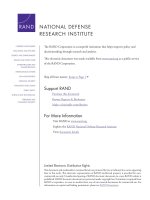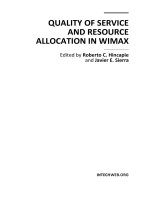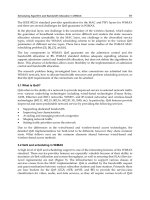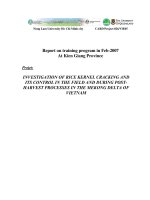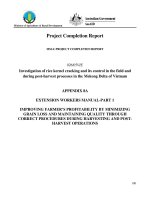Quality Assurance and Quality Control in the In Vitro Fertilization Laboratory pdf
Bạn đang xem bản rút gọn của tài liệu. Xem và tải ngay bản đầy đủ của tài liệu tại đây (248.93 KB, 16 trang )
17
Quality Assurance and Quality Control in
the In Vitro Fertilization Laboratory
Karen L. Martin
Academic Unit of Reproductive and Developmental Medicine, University of
Sheffield, Sheffield, South Yorkshire, U.K.
INTRODUCTION
The main objective of any in vitro fertilization (IVF) unit is to provide good
service for their patients. Although this can be interpreted in several ways, it
is usually perceived as achieving a live birth (1). One of the most important
factors contributing to this outcome is the performance of the IVF labora-
tory responsible for the creation of embryos from patients’ gametes. The
viability of the embryos created and transferred into the woman’s uterus
is a major determinant in establishing a successful pregnancy. As the devel-
opment and viability of gametes and embryos in vitro is compromised by
contaminants and relatively small fluctuations in the environment, such as
temperature and pH (2,3), it is imperative that optimal culture conditions
for gametes and embryos are attained and maintained in the IVF laboratory
to ensure the best care for patients. The purpose of employing quality assur-
ance (QA) and quality control (QC) schemes is to ensure reproducibility
in all methods and performance within the IVF laboratory (4), and thus
provide consistent, optimal conditions for gamete and embryo culture. More-
over, the diagnostic as well as the therapeutic role of the IVF laboratory can
benefit from employing QA and QC programs (5).
365
WHAT ARE QA AND QC?
QC involves measures and activities undertaken to control the quality of
products, methods, equipment, and environment to ensure that the lab-
oratory is functioning correctly, and is carried out to prevent undetected
problems leading to a compromise in service to the patient. Internal quality
control (IQC) refers to those measures undertaken on site.
QA is a comprehensive program that includes all activities and pro-
grams intended to ensure or improve the performance of the laboratory
and thus the quality of care to patients. QA includes measures such as rec-
ord keeping, evaluation and education of laboratory staff, results reporting,
treatment auditing, incident reporting, etc., as well as QC methodology.
Both QA and IQC are systems that look within a particular testing
site. In comparison, external quality assessment (EQA) looks at differences
between different sites testing the same analyte to ensure continui ty of
patient care between institutions and/or to ensure standards meet those
of accredited/regulatory bodies.
WHY EMPLOY QA AND QC SCHEMES IN THE IVF
LABORATORY?
Until relatively recently, QA and QC programs were little employed within
IVF laboratories despite their obligatory use and proven benefits in other
types of clinical facilities. Although this was originally attributed to IVF
being a new field of medicine which did not fall under the auspice s of any
accreditation/regulat ory authorities, 25 years later, changing legislation in
some countries and/or the need to raise standards to compete with other
units is leading to greater numbers of IVF laboratories employing QA
and QC schemes. Furthermore, QA and QC programs have not only been
shown to benefit the running of an existing IVF laboratory (4,5), but are
also invaluable when setting up new facilities (6). The benefits and appli-
cation of QA and QC schemes will therefore be discussed in relation to both
the new and the established IVF unit.
Benefits of Employing QA and QC Schemes When Setting Up a
New IVF Laboratory
When setting up a new IVF laboratory, or even making alterations to an
existing laboratory, there are usually a large number of new and untested
variables which should be validated before use in clinical practice. This
may apply to equipment, methodology, environment, consumables, and /
or culture media. The use of QA and QC to test these new variables will
ensure that optimal standards of practice are attained from the outset in
the new IVF laboratory, thus ensuring that patient treatment is not com-
promised. In a prospective analysis, Cutting et al.(6) demonstrated that
366 Martin
employment of a QC scheme identified problems with equipment before
treatment commenced when setting up the Assisted Conception Unit (ACU),
Center for Reproductive and Developmental medicine (CRMF), Sheffield
Teaching Hospitals Foundation Trust, Jessop Wing, Sheffield, U.K. These
problems are likely to have led to a compromise in pregnancy rates if they
had gone unchecked. As such, QC can give confidence to the scientific staff
and thus the whole IVF team that gamete and embryo development are not
compromised by new laboratory facilities and procedures.
The use of EQA where possible is also important to ensure that lab-
oratory practices and personnel in the new IVF laboratory are compara ble
to acceptable standards of other laboratories or preferably accredited/
regulatory bodies. Again this ensures that patient treatment is not compro-
mised at the expense of a learning curve and gives confidence to the IVF
team from the outset.
Benefits of Employing QA and QC Schemes in an Established
IVF Laboratory
There are several advantages of employing QA and QC schemes in the estab-
lished IVF laboratory. These include ensuring optimal laboratory performance
is consistent and maintained. Their use also allows rapid and effective trouble-
shooting should there be a problem such as a decrease in fertilization rate. As
such, QC especially allows the staff to determine whether the cause lies within
the laboratory, and if so, where the problem resides (4). Identifying problems
through QC should therefore lead to an improvement in work processes and
protocols. More importantly, a QC scheme should detect problems before they
become significant and impact on the care of patients.
In addition to the above, QA and QC are also useful when incor-
porating new technologies and/or methodologies into the established IVF
laboratory and thus for improving laboratory performance. This is partic-
ularly applicable to the field of assisted reproductive technology as new
developments are frequently emerging. Validation and monitoring of
new methods and techniques is important as the introduction of new proce-
dures can compromise the quality of service to patients. The effectiveness of
new techniques and protocols can be readily assessed with QA and QC
measures giving confiden ce to the team upon implementation of the new
procedures. In turn, moving forward confidently with new developments
educates and thus motivates the team as well as improving patient care.
The use of EQA in the existing laboratory is important for evaluating
personnel performance as part of their career development, thus highlight-
ing training and educational needs, which in turn should also motivate staff.
Employing EQA to check whether laboratory performance meets specified
requirements also increases customer confidence and the credibility of the
IVF unit placing it in a more competitive position with its counterparts.
Quality Assurance and Quality Control in the IVF Laboratory 367
WHAT COMPRISES A QC PROGRAM?
A QC program involves the monitoring of: (i) equipment; (ii) culture media
and consumables; (iii) the environment; and (iv) protocols. When setting up
a new IVF unit or introducing new changes to an already established labora-
tory, validation of any new variables is required, which once established to
be satisfactory should then be regularly monitored. All testing, whether it is
the initial validation or routine monitoring, should take place at an
adequate frequency using appropriate, accurate, reliable, and preferably
accredited testing methods. Furthermore, all aspects of the testing should
be accurately documented.
Equipment Validation
All new and major items of equipment (e.g., flow hoods, incubators, etc.)
should be installed by the manufacturer and properly commissioned with
certification. Even then, internal validation using QC measures of the equip-
ment before its use in clinical practice is highly recommended to ensure that
it meets the manufacturer’s specifications (6). All new major items of equip-
ment should be switched on monitored regularly allowing sufficient time for
performance validation to ensure that problems are clearly identified and
rectified before use in clinical treatment. The time required to validate an
item of equipment will vary depending on its function. In setting up the
ACU, CRMF in Sheffield, a period of 2 months was allowed to run and test
new major items of equipment after their installation before employing them
in clinical practice (6). As a result, problems were identified and solved with
major items of equipment that otherwise would not have been detected if
testing had lasted only a relatively short period of time.
Table 1 summarizes the types of equipment tested in situ within the
ACU, CRMF, the type of test used and the frequency of testing. In addition
to the tests listed, a mouse embryo bioassay was also used to assess the
incubators before use in clinical treatment for their ability to support mam-
malian embryo development. Although the mouse embryo bioassay is
generally considered a biologically relevant bioassay (7), it has been criti-
cized for being insufficiently sensitive (8). However, its sensitivity can be
manipulated by taking into account the strain of mouse used, the stage of
embryo retrieval and culture, and the type of c ulture medium used (4,9).
To test the three incubators in the ACU, CRMF, mouse 2-cell embryos
of the MF-1 strain were randomly divided between these and a fourth
(control) incubator in which success ful mouse embryo development had pre-
viously been established. The control incubator was located in a separate
research laboratory in the hospital within the Academic Unit of Repro-
ductive and Developmental Medicine, University of Sheffield. Groups of
50 embryos were cultured in 50 mL microdroplets of KM3 medium (10)
overlaid with liquid paraffin oil at 5% CO
2
in air and 37
C (11). Embryo
368 Martin
Table 1 Internal Quality Control Measures Used to Assess the Performance of New Equipment Installed in the Assisted Conception
Unit, Centre for Reproductive and Developmental Medicine, Sheffield, U.K.
Equipment Manufacturer Model Test
Frequency
of testing Method RangeÆ accuracy
Incubator Heraeus BB6220 CO
2
(%) Weekly Fyrite gauge 5Æ 0.5%
Temperature Daily Max/min thermometer À10
Ctoþ50Æ 1
C
Environment As required Mouse bioassay n/a
Water system Vivendi Purelab Endotoxin Weekly Limulus 0.03 EU/mL
Maxima Amoebocyte
Lysate test
Refrigerator LEC LR500 Temperature Daily Max/min thermometer À10
Ctoþ50Æ 1
C
Heated stages MAT
a
BioMAT2 Temperature Monthly Surface thermometer À50
Ctoþ150Æ 0.1
C
Hunter
a
Hunter N24 Temperature Monthly Surface thermometer As above
Hunter 200AIN Temperature Monthly Surface thermometer As above
Hot blocks Grant QBT2 Temperature Monthly Mercury thermometer À20
Ctoþ150Æ 5
C
Hot oven Gallenkamp OVB-307 Temperature Every use Temperature indicator
strips
121
C to 160Æ 2%
Cryopreservation
equipment
Planar Kryo 360 Function Every use Test run with
medium only
n/a
a
Integral to class II f low hoods.
Source: From Ref. 6.
Quality Assurance and Quality Control in the IVF Laboratory 369
morphology and cleavage rates were monitored daily over a period of 5 days
and the percentage of embryos reaching the blastocyst stage on day 5 post-
fertilization compared using Fisher’s exact test (Fig. 1).
Using the QC measures outlined in Table 1 and the mouse embryo
bioassay, several problems were identified with the new equipment installed
and commi ssioned by the manu facturers in the ACU, CRMF, including the
incubators, refrigerators, and the water purification system (6). The tempera-
ture of two of the incubators took more than ten weeks to stabilize at 37
C,
whereas the third incubator exhibited unacceptable fluctuations even after
this period of time (Fig. 2). Furthermore, the CO
2
levels in the third incuba-
tor also failed to stabilize satisfactorily (Fig. 3). The sub-optimal performance
of the third incubator was confirmed by the mouse embryo bioassay. The
proportion of mouse embryos reaching the hatched blastocyst stage using
this instrument was significantly lower than that achieved by the control incu-
bator (p < 0.05, Fisher’s exact test; Fig. 1). The QC measures also identified a
problem with two of the refrigerators which both failed to maintain the cor-
rect temperature for storing embryo culture medium (i.e., 2–8
C; Medicult,
U.K.). The temperature of both refrigerators was consistently between 8 to
10
C. The ultra-pure water tested positive for endotoxins (> 0.03 EU/mL)
on two separate occasions. Sanitization was carried out immediately accord-
ing to the manufacturer’s instructions and the equipment re-tested. On both
occasions, the water tested negative following sanitization.
Figure 1 The percentage of 2-cell mouse embryos of the MF-1 strain reaching the
hatched blastocyst stage in three new incubators newly installed in the Assisted Concep-
tion Unit, Centre for Reproductive Medicine and Fertility, Sheffield, U.K. and a fourth,
control incubator located in the Academic Unit of Reproductive Medicine and Fertility,
University of Sheffield. Ãp < 0.05. Fisher’s exact test. Source:FromRef.6.
370 Martin
One of the main outcomes from this study was that independent dou-
ble-checking and performance validation of new equipment before use in
clinical treatment, even after installation and commissioning by the manu-
facturer, is very important.
Figure 2 Temperature recordings from three incubators newly installed in the
Assisted Conception Unit, Centre for Reproductive Medicine and Fertility, Sheffield,
U.K. All readings were carried out daily using a using a maximum /minimum
thermometer (À10
Ctoþ50 Æ 1
C). Source: From Ref. 6.
Figure 3 CO
2
recordings from three incubators newly installed in the Assisted Con-
ception Unit, Centre for Reproductive Medicine and Fertility, Sheffield, U.K. All
readings were carried out weekly using a fyrite gauge (À10
Ctoþ50 Æ 1
C). Source:
From Ref. 6.
Quality Assurance and Quality Control in the IVF Laboratory 371
Equipment Monitoring
Following installation and validation, continuous and regular monitoring of
the equipment once in clinical use is imperative to ensure its performance is
maintained and that problems are detected as they occur. In the ACU,
CRMF, independent temperature recordi ngs of the refrigerators and incu-
bators continued to be tested daily, the hot blocks and heated stages
monthly, and the hot oven every time it was used; the CO
2
levels in the incu-
bators were monitored weekly. The cryopreservation equipment was also
assessed after each freezing run by checking that the printed readout detail-
ing the embryo cryopreservation program followed the specified program
details (6). Taking into account the manufacturers’ recommendations on
frequency of servicing, all equipment was also placed on a service contract
(6). Regular servicing of items of equipment minimizes the risk of equipment
malfunction and, although seemingly expensive at the outset, is usually cost-
effective in the long-term.
Culture Media and Consumables Validation
Certification of product QC testing by the manufacturer should be obtained
for all consumables used in the laboratory. Given the increasing wide choice
and availability of culture media and other chemicals/solutions for human
IVF, it is becoming less acceptable to make such con sumables in-house
unless they are rigorously assessed using QC. However, even when pur-
chasing company-manufactured media, detailed inspection and critical
evaluation of a company’s QC program is essential to ensure that it meets
appropriate standards for IVF. For example, some manufacturers lay claim
to using the mouse embryo bioassay to test their products. However, their
definition of cytotoxicity may be <40% blastocyst development using an
F1 hybrid or inbred strain. This is a very low cut-off point which may
not identify all embryo toxic products. Furthermore, proof of testing upon
delivery of each new batch of consumables/culture media is not always
forthcoming (4). Once again, QC of new consumables, even those already
QC-tested by the manufa cturer, is recommended before their use in the
IVF laboratory to ensure their suitability. This is especially applicable to
those consumables not specifically designed for use in IVF (e.g., gloves,
some cell culture flasks, and dishes) which may be suitable for culturing
other types of mammalian cells but may prove to be embryo toxic (12).
A useful method for testing consumables is the human sperm survival
assay (13). This is an inexpensive and convenient bioassay, not involving the
use of animals, which monitors sperm survival over hours/days in culture
while in contact with the products. As with the mouse embryo bioassay,
consideration must be given to the conditions under which the assay is per-
formed to ensure appropriate sensitivity to detect cytotoxicity of clinical
significance. Claassens et al. (14) found that optimum sensitivity was
372 Martin
achieved when sperm were cultured in the absence of serum. A calculated
sperm motility index value of < 0.75 was used to indicate sperm toxicity,
and items identified as sperm-toxic within eight hours were considered to
be of clinical significance due to close agreement with the mouse embryo
bioassay (14). Validation of consumables before use in clinical treatment
is important to ensure that an alternative product can be sourced should
they prove to be unsuitable. If an alternative product needs to be found then
sperm survival tests should be repeated as appropriate.
Culture Media and Consumables Monitoring
Despite QC testing by the manufacturer and initial validation of a prod uct,
QC testing of all new batches of culture media is important because trans-
port and incorrect storage conditions can affect media quality (4). The
QC measures should include testing for endotoxin levels because their
presence in embryo culture medium can cause a significant decrease in preg-
nancy rates (15). The limulus amoebocyte lysate test is a simple and rapid
method for checking endotoxin levels in company-manufactured media as
well as the water of any in-house water purification system (6). The osmolar-
ity of all new batches of culture medium should also be checked to ensure that
it is within the acceptable range based on the manufacturer’s information.
Similarly, all new batches of plastics and other consumables should be
subject to a sperm survival test because seemingly minor changes in the
manufacturing process can affect the quality of the product rendering it
embryo-toxic. Moreover, the manufacturers sometimes fail to report
changes in specifications/manufacturing process to end users.
The batch / lot numbers for all consumables and media to come into
contact with gametes and embryos should be documented, preferably in
each patients’ records, to ensure comprehensive tracing of every product
should a problem arise (4).
Environment Validation
Involvement in the planning and design of a new IVF unit, or building/
decorating alterations to an existing unit, can save a lot of trouble further
down the line. At the first instance, consideration should be given to possible
sources of indoor air contaminants because volatile organic compounds
(VOCs) and chemical airborne contaminants (CACs) can significantly affect
mouse embryo culture (2). Factors affecting the levels of internal air
pollutants include the air quality outside the building, equipment, heating,
ventilation and air-conditioning systems, human activities, buildi ng compo-
nents and furnishings, and other temporary sources such as redecorating
and repair activities. When possible, consideration should therefore be given
to the site and location of the laboratories. The use of air purification units
such as the CODA
1
towers and positive pressure airflow in the laboratories
Quality Assurance and Quality Control in the IVF Laboratory 373
should also be considered, if necessary, to reduce the levels of airborne con-
taminants. To minimize the levels of VOCs and CACs when setting up the
ACU, CRMF, sealants and toxic glues were avoided, and low odor specia-
lized paint was used for decorating the laboratories (6). The quality of the
gas supplying the incubators and the type of pipework used should also be
carefully considered. Class II biological safety cabinets with High efficiency
particulate air-filtered air, which provide personnel as well as environmental
and product protection, were also installed for all gamete and embryo hand-
ling. The positioning of air conditioning or purification units should be
carefully considered so that the airflow of the class II biological cabinets is
not compromised.
Laboratory lighting should also be taken into accoun t at the planning
stage because ultraviolet (UV) light may have detrimental effects on mam-
malian oocyte maturation and embryo development (16,17). Tungsten light
bulbs controlled by dimmer switches can be installed to provide low-level
lighting in the laborato ries (6). Alternatively, UV light filtration units can
be used to filter out harmful UV wavelengths on fluorescent lights.
Once building works/decorating is completed, microbiology testing of
the air quality by an accredited laboratory is recommended. At the ACU,
CRMF, swabs and settle plates were used to test the presence of fungus
or colony-forming units (CFUs) on laboratory surfaces and in the incuba-
tors and flow hoods (6). Acceptable limits of air quality for a clean area were
considered to be <100 CFUs and no fungus (Department of Microbiology,
Royal Hallamshire Hospital, Sheffield, U.K.) and less than one CFU and no
fungus within the class II f low cabinets (18). Initial validation of the air
quality within the new laboratories before treatment commenced was found
to be satisfactory (Fig. 4—August). Similarly, no bacterial growth was
Figure 4 Microbiological testing of air quality in the in vitro fertilization laboratories
of the Assisted Conception Unit, Centre for Reproductive Medicine and Fertility,
Sheffield, U.K. Abbreviation: CFUs, colony-forming units. Source: From Ref. 6.
374 Martin
observed in the initial validation of the water from the in-house water
purification system. However, microbiological testing revealed that fungi
were present in two of the three incubators (Fig. 5), both of which were
humidified. The third incubator was non-humidified and had no infection.
Therefore, after thorough cleaning and retesting, protocols were reviewed
and all three incubators were run non-humidified. Tests were carried out
to ensure that the osmolarity of the culture medium overlaid with oil was
stable for > 2 days (6).
The safety and security of gametes and embryos as well as that of staff
working in the laboratories is also important. Alarm systems can be
installed to detect a number of variables including liquid nitrogen levels in
gamete and embryo storage dewar s, environmental oxygen levels in the
cryopreservation laborat ory, and pressure in the pipes supplying CO
2
to
the incubators (6). All alarms should be validated prior to use and subject
to QC and monitoring once in use. All alarms should be linked to a central
control system which will alert staff to any fault 24 hours a day.
Environment Monitoring
Regular monitoring of the environment in the established laboratory is
important to ensure that appropriate standards are maintained (2,19).
Microbiology and bacteriology testing, as outlined above at ACU, CRMF,
was carried out every month once treatment commenced. This regularity
of testing revealed a high number of CFUs in the laboratory air in the
month of September and was attributed to an engineer carrying out equip-
ment maintenance the day before the air was sampled (Fig. 4). As a result,
laboratory protocols were amended to include a weekly rota for cleaning the
Figure 5 Microbiological testing of three incubators newly installed in the Assisted
Conception Unit, Centre for Reproductive Medicine and Fertility, Sheffield, U.K.
Abbreviation: CFUs, colony-forming units. Source: From Ref. 6.
Quality Assurance and Quality Control in the IVF Laboratory 375
laboratories and an additional cleaning procedure after any maintenance or
servicing had been carried out.
Other environmental parameters should also be closely monitored
including laboratory temperature and if possible levels of VOCs and CACs.
WHAT COMPRISES A QA PROGRAM?
QA includes QC as well as a number of other measures such as those listed
below. This list is by no means comprehensive but illustrates what QA mea-
sures can be employed to monitor and improve laboratory performance,
and thus improve patient care.
Treatment Monitoring
Validation of Laboratory Performance in a New IVF Unit
Before commencing IVF in a new center, other types of treatment such as
intrauterine insemination (IUI) can be started and monitored to assess some
aspects of laboratory practice, including protocols and consumables. For
example, at the ACU, CRMF, the clinical pregnancy rate of 40 cycles of
stimulated IUI was monitored before IVF treatment was started. A 35%
clinical pregnancy rate (fetal heart detected per treatment) was achieved
after 40 cycles suggesting no negative effect on sperm function following
gamete preparation in the Andrology Laboratory.
Monitoring of Laboratory Performance in an
Established IVF Unit
Performance of the IVF laboratory can be monitored by auditing fertiliza-
tion and embryo cleavage rates and embryo quality at an appropriate
frequency depending on the center’s activity (20). The pregnancy rate,
implantation rate, and multiple birth rates can also be audited. However,
when interpreting these statistics, consideration must be given to the activity
of the unit and the types of patients treated, etc (1). Furthermore, pregnancy
rate alone should not be used as a QC measure to audit the performance of
the laboratory. This is not least because it is affected by other variables, but
also because a drop in pregnancy rate identifies a problem encountered at
the time of treatment usually weeks before. A good QC program detects
problems before they affect the pregnancy rate. Moreover, using pregnancy
rate as a QC measure does not identify the source of the problem (4).
Record Keeping and Documentation
Fundamental to the success of an QA program is accurate documenta tion
and record keeping of all aspects of the scheme. In designing the paperwork,
376 Martin
thought should be given to information retrieval, traceability, and security
of the documents. The option of using computer records should also be
considered. Sy stems should also be in place to ensure that information is
accurately recorded when trans ferred from one format to another. All stan-
dard operating procedures and protocols should also be documented and
updated frequently, and made readily available to all staff.
With regards to the IVF laboratory, the monitoring of gametes and
embryos from the time of collection to treatment outcome should be docu-
mented tho roughly together with accurate recording of patient information.
A system should be in place to double check that information is accurately
recorded during laboratory procedures, particularly when it comes to iden-
tifying patients’ gametes and embryos. In the United Kingdom, under the
regulation of the Human Fertilization and Embryology Authority, it is
now obligatory that all laboratory procedures involving the manipulation
and transfer of patient’s gametes and embryos are witnessed and documen-
ted by a second member of staff.
Incident Reporting
However minor they seem at the time, all incidents/events should be
reported and documented as soon as possible as they may lead to an unfore-
seen effect on laboratory performance and/or treatment outcome. For
example, recording the servicing of a flow cabinet enabled laboratory staff
of the ACU, CRMF, to account for an unexpected increase in CFUs
detected in the air quality (6).
Appraisal of Personnel Performance
EQA can be used to appraise the performance of laboratory staff in various
procedures. For example, the U.K. National External Quality Assessment
Service (NEQUAS; www.unequas.org.uk) offers schemes for assessing
various andrology investigations including semen analysis, sperm antibody,
and sperm motility testing. Unfortunately, there are few national and even
fewer international accredited EQA schemes for other procedures used
within the IVF laboratory. However, internal assessments can be devised
to appraise the performance of personnel in methods such as therapeutic
embryo grading (5).
The primary purpose of regular staff evaluation is to identify areas for
improvement and further training. All staff should undergo regular apprai-
sals with their head of department and all skills and training of staff
accurately documented (1). Training should preferably be certified accord-
ing to a recognized body such as the Association of Clinical Embryologists
(ACE) in the United Kingdom, which offers two types of programs, the
Certificate and the Diploma, both of which are carried out in-house but
are assessed externally (21).
Quality Assurance and Quality Control in the IVF Laboratory 377
INTERNATIONAL STANDARDS OF QA AND QC
Given the advantages of employing the QA and QC measures outlined
above, why has it taken so long for the IVF laboratory to routinely employ
these schemes? Reasons include the lack of appropriate and specific stan-
dards with which to comply, and regulatory authorities to enforce them.
Time and money also need to be invested at the outset to implement and
then run QA and QC program s. To date, self-motivation has been the major
factor driving units to employ QA and QC schemes; however, legislation is
now increasingly putting pressure on IVF units to employ such program.
On a national level, evidence of QA and QC in the IVF laboratory is
becoming a requirement in some countries with various inspecting authori-
ties such as the Human Fertilisation and Em bryology Authority (HFEA) in
the United Kingdom, and the Society for Assisted Reproductive Technology
(SART) in the United States. Furthermore, IVF units within the European
Union (EU) will have to comply with the EU Tissues and Cells Directive by
April 2006, which requires units to have QC and QA systems. Some coun-
tries also now have governing bodies that can evaluate and certify IVF
laboratories. In the United States, there are various organizations that offer
this service including the Joint Commission on Accreditation of Healthcare
Organizations and the College of American Pathologists. For those coun-
tries without national accrediting bodies, there are guidelines available for
IVF laboratories issued by recognized societies within the field such as the
ACE standards and guidelines for IVF laboratories (21) and the ESHRE
guidelines for good practice in IVF laboratories (22), which include recom-
mendations for QA and QC. However, these guidelines are not obligatory
and are usu ally too generalized. The importance of having internationally
recognized standards for QA and QC is therefore now being realized (1).
The International Standards Orga nisation (ISO) is a non-govern-
mental organization and the world’s largest developer of international
standards (23) It is currently comprised of a network of national standard
institutes from 148 countries, with one body representing each country
and a central secretariat based in Geneva, Switzerland, which coordinates
the system. Its purpose is to set internationally recognized standards to
enhance quality, increase reliability, and improve health and safety of pro-
ducts and services world-wide.
The first European IVF unit to apply for internationally recognized
accreditation was the Fertility Centre of Scandinavia, Goteberg, Sweden,
which applied for ISO/IEC 17025 (formerly ISO/IEC Guide 25). These
are standards jointly devised by ISO and its international partner, the Inter-
national Electrotechnical Commission General, which defines Requirements
for the Competence of Testing and Calibration Laboratories (4). The ISO
9000 series, more specifically ISO 9001:2000, is now the more common stan-
dard applied for by IVF units. ISO 9001:2000 specifies ‘‘requirements for a
378 Martin
quality management system for any organization that needs to demonstrate
its ability to consistently provide a product or service that meets customer
and applicable regulatory requirements, and thereby aims to enhance cus-
tomer satisfaction.’’ Thus, conformance to ISO 9000:2000 is said to guaran-
tee that a company delivers quality products and services.
To apply for ISO 9000:2000 an IVF unit’s management team initially
needs to define and formally document its QA policies and objectives and
how these will be implemented. An external consultant can be employed
to assist in this process. Once the documentation is in place and the QA
measures have been implemented, an external assessor examines the unit’s
QA system to ensure it complies with ISO 9000:2000. A detailed report is
then submitted describing sections of the standard that the unit has failed
to comply with. The unit is then given a specified time limit in which to cor-
rect the problems. Once these have been addressed, the unit is certified as in
conformance with the standard.
The benefits of having internationally recognized standards are several
fold (1). They include overcoming differences between national standards,
thus allowing comparisons between laboratories in different countries. Fur-
thermore, the use of internationally recognized practices should improve the
standards and therefore the success rates of IVF. As the benefits of inter-
nationally recognized QA and QC schemes are now being realized, the num-
ber of ISO-accredited IVF units is on the increase. This can only serve to
benefit the reputation of IVF as a clinical science but also the patients for
whom they care.
REFERENCES
1. Alper MM, Brinsden PR, Fischer R, Wikland M. Is your IVF programme good?
Hum Reprod 2002; 17:8–10.
2. Hall J, Gilligan A, Schimmel T, Cecchi M, Cohen J. The origin, effects and
control of air pollution in laboratories used for human embryo culture. Hum
Reprod 1998; 13:146–151.
3. Gardner DK, Lane M. Embryo culture systems. In: Trounson AO, Gardner DK,
eds. Handbook of In vitro Fertilization. Boca Raton: CRC Press, 1999:205–264.
4. Wikland M, Sjoblom C. The application of quality systems in ART programs.
Mol Cell Endocrinol 2000; 166:3–7.
5. Matson PL. Internal quality control and external quality control assurance in the
IVF laboratory. Hum Reprod 1998; 13(suppl 4):156–165.
6. Cutting R, Pritchard J, Clarke H, Martin K. Establishing quality control in the
new IVF laboratory. Hum Fertil 2004; 7:119–125.
7. Quinn P, Horstman F. Is the mouse a good model for the human with respect to
the development of preimplantation embryo in vitro? Hum Reprod 1998;
13(suppl 4):173–181.
8. Rinehart JS, Bavister BD, Gerrity M. Quality control in the in vitro fertilisation
laboratory: comparison of bioassay systems for water quality. J In Vitro Fertil
Embryo Transf 1988; 5:335–342.
Quality Assurance and Quality Control in the IVF Laboratory 379
9. Zarmaoupis-Zavos PN, Zavos PM. Factors that may influence the mouse
embryo bioassay. Tohoku J Exp Med 1996; 179:141–149.
10. Morris KA, Martin KL. Effects of activin A on embryo development during
implantation in vitro [abst]. Reproduction 2002; 28:35.
11. Martin KL, Leese H. Role of glucose in mouse preimplantation embryo devel-
opment. Mol Reprod Dev 1995; 40:436–443.
12. Reddy VR, Thomas TS, Wright HR, et al. The scientific basis of surgical glove
selection in an in vitro fertilisation laboratory. J Biomed Mat Res 1999;
48(4):569–571.
13. Critchlow JD, Matson PL, Newman MC, et al. Quality control in an in vitro
fertilisation laboratory: use of sperm survival studies. Hum Reprod 1989; 4:
545–549.
14. Claassens OE, Wehr JB, Harrison L. Optimizing sensitivity of the human sperm
motility assay for embryo toxicity testing. Hum Reprod 2000; 15:1586–1591.
15. Snyman E, Van der Merwe. Endotoxin-polluted medium in a human in vitro
fertilisation program. Fertil Steril 1986; 46:273–276.
16. Bradshaw J, Jung T, Fulka J Jr., et al. UV irradiation of chromosomal DNA and
its effect upon MPF and meiosis in mammalian oocytes. Mol Reprod Dev 1995;
41:503–512.
17. Evans J, Wells C, Hood K. A possible effect of different light sources on preg-
nancy rates following gamete intra-Fallopian transfer. Hum Reprod 1999;
14:80–82.
18. Department of Health: A code of practice for tissue banks, providing tissues of
human origin for therapeutic purposes. Medicines Control Agency, Department
of Health, ISBN 1 841823295, 2001.
19. Cohen J, Gilligan A, Esposito W, Schimmel T, Dale B. Ambient air and its
potential effect on conception in vitro. Hum Reprod 1997; 12:1742–1749.
20. Balaban B, Urman B. Embryo culture as a diagnostic tool. Reprod Biomed
Online 2003; 7:671–682.
21. (www.ace.ivf.net).
22. Gianaroli L, Plachot M, van Kooij R, et al. ESHRE guidelines for good practice
in IVF laboratories. Committee of the special interest group on embryology of
the European Society of Human Reproduction and Embryology. Hum Reprod
2000; 15:2241–2246.
23. (www.iso.org).
380 Martin
